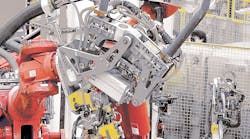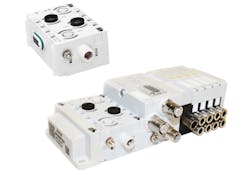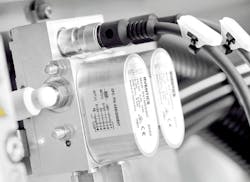Advanced Electropneumatic Positioning Achieves Dynamic Force Control
Content has been updated as of Oct. 20, 2021.
Linear devices that lift, move, and place a load require tight closed-loop positioning accuracy, which either pneumatic and electromechanical technologies can provide. However, between the two technologies, variables affect manufacturing costs, safety, and productivity in different ways. Moreover, recent developments in applying multiple closed-loop control to electropneumatic positioning systems (EPS) bring a new level of precision and safety by using dynamic force control to maintain load position, overcoming traditional E/P, and electromechanical system limitations.
How Electromechanical and Pneumatic Systems Differ
Electromechanical positioning systems. With any positioning system, accuracy is critical, including along any point of the motion path, but also at the actuator endpoint. An electromechanical system (EMS) performs positioning tasks by using electric servo motors and servo controllers with toothed belt axes, spindle axes, or electromechancial cylinders to move loads.
An advantage of an EMS is that it can accommodate high-speed production systems that require high accuracy for positioning control.
But there are disadvantages:
- Thermal: Electromechanical positioning systems can heat up and undergo temperature-related changes. Significant downtime is needed for cooling to avoid excessive wear and tear. In fact, many low-cost EMS platforms are only capable of 50% duty cycles, spending as much time off as they spend working.
- Electrical: If power is lost, an EMS can reset but work is lost prior to the power outage. Productivity suffers as a result.
- Financial: Cost can be an issue. Over the long term, the need to replace failure-prone electromechanical components can lead to higher maintenance and production costs. When an electromechanical system has issues, it typically requires an expensive new electric drive.
Traditional electropneumatic systems. To move an actuator to the required location, an EPS uses electrically actuated valves to control air flow, pressure, or both. Typical components of an EPS include a pneumatic cylinder, valves, electropneumatic pressure regulators, and related sensors. The pneumatic cylinders typically include both conventional and rodless versions. Many systems use basic flow-control valves and open-loop operation for positioning, which require large amounts of air flow. Other systems use direct-acting proportional pressure control combined with typical analog signals and single feedback circuits to enhance positioning accuracy and system efficiency.
Compared to an EMS, a traditional EPS has the advantage of providing greater productivity, better reliability, and more maintenance options for repair. They are often more energy efficient; unlike EMS (that use servo motors), EPS consume no electricity when holding a position. Overall, an EPS can provide lower cost of ownership than an EMS.
There are more advantages:
- Reliability: Maintenance issues occur far less frequently, as an EPS does not overheat. Components stay cool and can work around the clock in a 100% duty cycle. They can withstand harsh conditions such as temperature extremes, dusty conditions, and wet and dirty environments.
- Electrical: If power is lost, an EPS can use standard pneumatic valves to block air flow, which automatically freezes the position of the cylinder piston. It is also much easier to restart operation when power is restored.
- Financial: When pneumatic cylinders break or wear out, they can be repaired or replaced at a low cost and typically are easy to install. These advantages, combined with the inherent low-maintenance nature of pneumatic devices, significantly lower the cost of ownership compared to EMS. In fact, the cabling alone on an electromechanical device can cost more than an entire pneumatic system.
There is one disadvantage: An EPS cannot be perfectly sealed, so an incremental or intermittent loss of air or pressure is unavoidable. Minor leaks can cause the pneumatic cylinder to move slightly (drift). Low air flow can cause the cylinder to begin undergoing stiction, or chatter, which degrades system accuracy and performance. However, electropneumatic systems using direct-acting proportional pressure control can reduce the effects of stiction.
Advanced Electropneumatic Positioning with Dynamic Force Control
The ability to accurately control position is critical in any type of positioning system. Many applications typically require a specification for zero deviation from setpoint once the load reaches the desired position.
With an EPS, a conventional solution is to include a rod lock on the end of a piston rod when force control is required. When the load reaches the desired horizontal or vertical movement, the mechanical rod lock engages to apply a braking force against the rod.
However, in certain dynamic applications where the position changes frequently, the rod lock could disengage or cause damage to the equipment during an abrupt change in position. If the rod lock disengages, this could cause the load to drop or lunge forward and create a safety issue.
Overcoming Perceived Limitations
One of the shortcomings of traditional electropneumatic systems is the inability to control both position and force. For example, maintaining welding tip force in automotive body welding applications at an accurate position is very difficult to achieve. However, by using a closed-loop feedback system, advanced electropneumatic positioning systems can apply the additional pressure required at a given position to maintain the force needed to achieve an accurate weld.
The solution is to combine EPS regulators with advanced electropneumatic closed loop systems. This technology uses dynamic direct-acting proportional control valves combined with precision feedback for positioning. This combination enables higher performance and repeatability, all the while securing a position without the use of a mechanical rod lock and ensuring the load does not drop, move, or lunge forward.
High-dynamic EPS valves allow for high positioning accuracy and precision through the process of pressure regulation. They can achieve a resolution accuracy of within 0.12 psi during positioning. Dynamic force control is achieved by using multiple closed-loop control systems with the EPS regulators, rather than utilizing basic flow control valves and open-loop control. Some electropneumatic positioning systems offer one basic closed loop, which allows for precise positioning without providing force control.
Additional closed loops enhance monitoring and stability control, employing the process of feedback from pressure regulators on either side of the piston. Multiple closed loops also provide dynamic force control once the load and cylinder has reached the desired position.
Unlike a traditional EPS, advanced electropneumatic positioning systems with multiple closed-loop control can switch from dynamic positioning to force control via a quick parameter setting. This design augments the ability of precise pressure regulation to eliminate the effects of dithering. With a properly selected actuator and optimized tuning of the controller, it is possible to attain ±1 mm (or 1% of stroke) positioning accuracy.
Applications for Advanced Electropneumatic Positioning Systems
Systems using multiple closed-loop control systems are designed to provide an economical solution for a broad range of automation and industrial applications.
Application examples include automotive body welding (mentioned above), electropneumatic material handling systems (such as pick and place), hopper/damper/gate control, and other systems requiring precision indexing. Basically, suitable applications are anywhere force control is needed in addition to accurate positioning.
Traditional electropneumatic positioning systems have provided acceptable positioning for several years. An advanced electropneumatic system using multiple closed loops now allows dynamic force control and can compete with servo motor technology. Users will find that many applications do not require “ultra-precise” servo motors and can benefit from a more cost-effective electropneumatic solution with other inherent advantages. Due to safety and structural factors, system designers should consult with the manufacturer to account for the load, bore size, and stroke length needed for a particular application.
Aventics, for example, has a multiple closed-control loop positioning system available as a module that is compatible with current AV valve systems. The modularized design easily integrates into valve manifold assemblies to turn valves on and off using different communication protocols.
An advanced electronic pneumatic positioning system (AES) integrated with PID technology eliminates dithering associated with flow-based pneumatic positioners. And adding multiple closed-loop control enables dynamic force control for reliability and safety in securing load position.
This article was written and contributed by Jon Revlett, product specialist, Electro-Pneumatic Systems and Controls, at Aventics Corp., Lexington, KY.
This article is part of Power & Motion's Fundamentals of Fluid Power: Mechatronics ebook; download the full guide to learn about the latest technologies and design methods for developing modern pneumatic systems.




